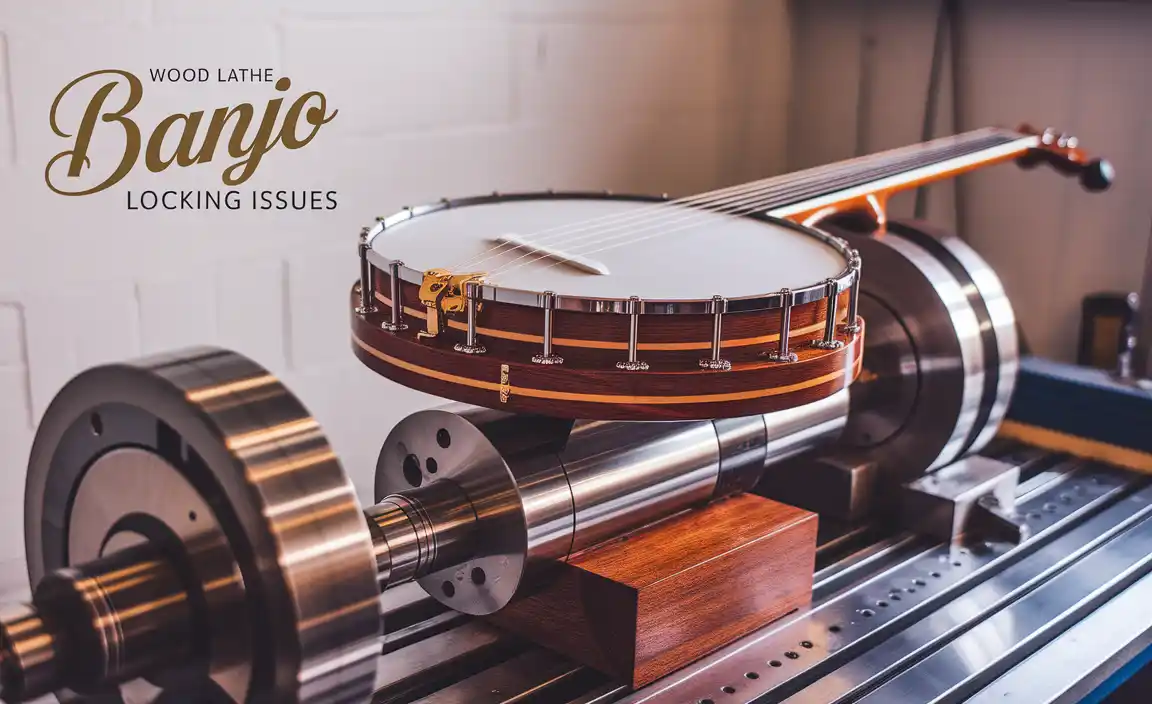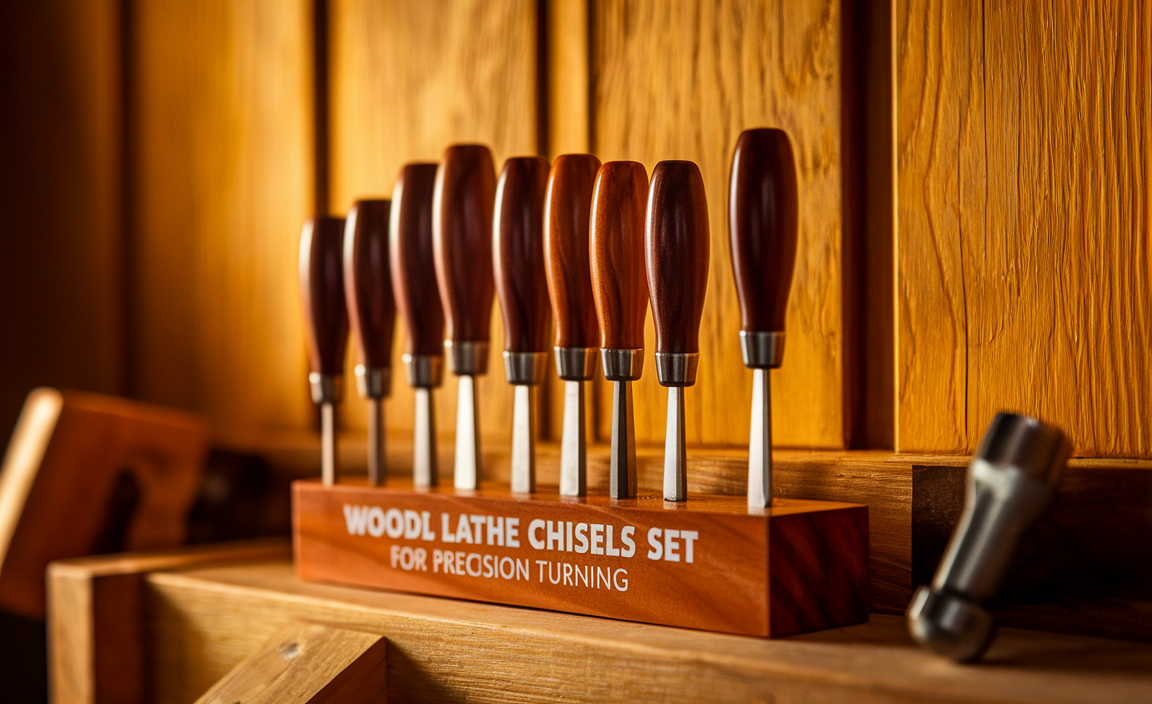Carbide end mills are crucial for woodworkers seeking precision and durability. They allow for clean cuts, intricate details, and efficient material removal in woods and composites, making them indispensable for CNC routing and detailed carving projects.
Hey there, fellow makers! Daniel Bates here from Lathe Hub. Ever look at those beautifully carved wood pieces and wonder how they achieve such clean lines and intricate details? Often, the secret weapon is a humble yet powerful tool: the carbide end mill. It might sound like something from a metal shop, but trust me, this tool is becoming an absolute game-changer for woodworkers. If you’ve found yourself frustrated with tools that chip, burn, or just can’t quite get that perfect finish on your wood projects, you’re in the right place. We’re going to dive deep into why carbide end mills are essential for your workshop, breaking down exactly what they are, why they’re so effective, and how you can start using them to elevate your woodworking. Get ready to upgrade your carving and routing game!
Understanding the Carbide End Mill: More Than Just a Router Bit
When you first hear “end mill,” you might picture a machinist at a big metal milling machine. And you wouldn’t be wrong! End mills are indeed the workhorses of metal fabrication. However, their precision, durability, and cutting capabilities have made them increasingly popular and essential for the modern woodworker, especially those venturing into CNC routing or detailed hand-carving.
So, what exactly is a carbide end mill? At its core, it’s a type of rotating cutting tool. Unlike a standard router bit that often has a bearing to guide it along a template or edge, an end mill is designed to cut on its sides and end. This allows it to plunge straight down into material (like drilling) and also sweep across to remove material, create pockets, or carve shapes.
The “carbide” part refers to the material it’s made from: tungsten carbide. This is an extremely hard and wear-resistant composite material. Think of it as super-steel for cutting tools. This hardness is key to why it’s so great for woodworking.
Why Carbide for Woodworking? The Benefits Unpacked
You might be thinking, “I already have router bits. Why switch?” That’s a fair question. While standard router bits are fantastic for many tasks, carbide end mills offer distinct advantages that can make a significant difference, especially for detailed or high-use applications.
- Superior Hardness and Durability: Tungsten carbide is incredibly hard. This means carbide end mills stay sharp much longer than conventional high-speed steel (HSS) bits. For woodworkers, this translates to fewer bit changes, consistent cut quality over time, and the ability to cut tougher materials.
- Cleaner Cuts: The hardness of carbide, combined with sharp cutting edges, leads to cleaner, more precise cuts. This is especially noticeable in woods prone to tear-out or chipping, like plywood, MDF (Medium-Density Fibreboard), and certain hardwoods.
- Heat Resistance: Carbide can withstand higher temperatures before losing its hardness. This is important because friction during cutting generates heat. Better heat resistance means the bit stays sharper and performs better, especially during longer or more demanding cutting operations.
- Versatility: End mills can perform a wide range of operations. They can mill pockets, cut profiles, drill holes, and create intricate 3D carvings. This versatility makes them a go-to tool for CNC machines.
- Reduced Burning: While not entirely immune, carbide’s heat resistance and sharp edges help reduce the burning that can occur with softer bits, which tend to dull faster and create more friction.
Common Misconceptions About End Mills for Wood
It’s true that end mills originated in metalworking, and this can sometimes cause confusion. Some woodworkers might think they are only for metal. However, advancements in geometry and coating have made them exceptionally well-suited for wood and composites.
Another point of confusion can be the terminology. While “end mill” is the general term, different types exist for specific tasks (like ball-nose, flat-nose, compression, etc.). For woodworking, especially with CNCs, you’ll often encounter flat-nose and ball-nose end mills.
Types of Carbide End Mills Relevant to Woodworking
When you start looking for carbide end mills for your woodworking projects, you’ll notice variations. Understanding these differences will help you choose the right tool for the job. The primary factors are the number of flutes (the cutting edges), the geometry of the cutting tip, and specialized features.
Flutes: The Cutting Edges
Flutes are the helical grooves that run along the cutting part of the end mill. They serve two main purposes: to create the cutting edges and to provide a channel for the chips of material to escape. For woodworking, the number of flutes is a critical consideration:
- 1-Flute End Mills: These are excellent for softer woods and materials like foam or plastics. They offer large chip clearance, which is great for preventing chip recutting and burning. They can often run at higher feed rates.
- 2-Flute End Mills: This is a very common and versatile choice for hardwoods, softwoods, and composites like MDF and plywood. They offer a good balance between chip clearance and the number of cutting edges, leading to a good finish.
- 3-Flute End Mills: With more cutting edges, these can provide a smoother finish than 2-flute bits. However, they have less chip clearance, so they are often run at slower feed rates or are better suited for materials that produce smaller chips.
- 4-Flute End Mills: These offer the smoothest finish due to the most cutting edges. However, chip clearance is the most restricted. They are best for finishing passes or for materials that produce very fine dust, and require careful feed and speed management to avoid overheating.
Tip: For common woodworking tasks, especially on a CNC, 1-flute or 2-flute end mills are often the default go-to for general material removal and cutting. For finer finishes, you might explore 3 or 4-flute options.
End Mill Geometry
The shape of the tip and cutting edges also dictates what the end mill can do:
- Flat-Nose (or Square) End Mills: These have a flat tip. They are ideal for creating pockets, dados, rebates, and cutting out shapes with sharp internal corners (though actual square corners require a specialized corner-rounding end mill). They are workhorses for 2D cutting and precise profiles.
- Ball-Nose End Mills: These have a rounded tip, forming a hemisphere. They are essential for 3D carving, contouring, and creating smooth, curved surfaces. The radius of the ball determines the detail and smoothness of the curves. Smaller radii allow for finer detail.
- Compression End Mills: A hybrid designed for optimal performance in plywood and composites. They feature an up-cut spiral on the top edge and a down-cut spiral on the bottom edge. This combination pulls the workpiece material towards the center, resulting in a clean cut on both the top and bottom surfaces without needing a separate finishing pass or template.
Specialized Features
You might also encounter terms like “reduced neck” or specific coatings. A “reduced neck” end mill has a shank that is slightly smaller in diameter than the cutting head. This is useful for reaching into deep pockets or undercuts where a standard straight shank might hit the material. Heat-resistant coatings can further enhance performance and tool life, though for many wood applications, uncoated carbide is sufficient.
A specific mention of a “carbide end mill 1/8 inch 3/8 shank reduced neck for mdf heat resistant” points to a precise tool: a small 1/8″ diameter cutting head, mounted on a 3/8″ shank (common for CNC collets), with a slimmed-down neck for deeper reach, and designed to handle the heat generated when cutting MDF. This is a fantastic example of a specialized tool for demanding composite work.
Choosing the Right Carbide End Mill for Your Project
Selecting the correct end mill can seem overwhelming with so many options. Here’s a straightforward approach:
| Project Type | Recommended End Mill Type | Reasoning |
|---|---|---|
| General outline cutting (plywood, MDF) | 2-Flute, Flat-Nose | Good chip clearance for material removal, sharp edges for clean cuts. |
| 3D Carving/Sculpting | Ball-Nose (various radii) | Creates smooth, curved surfaces. Smaller radius for finer detail. |
| Plywood with clean top and bottom edges | 2-Flute or 4-Flute Compression End Mill | Combines up-cut and down-cut action to prevent tear-out on both surfaces. |
| Intricate detail work/small parts | 1/8″ or 1/16″ Ball-Nose or Flat-Nose | Smaller diameter allows for fine features. May be 2-flute for good balance. |
| Cutting deep pockets or undercuts | Reduced Neck End Mill (Flat or Ball-Nose) | Allows the shank to clear the walls of the pocket. |
| Softwoods, plastics, foam | 1-Flute End Mill | Excellent chip evacuation, preventing melt-back in plastics and chip recutting. |
Understanding Shank Diameter and Cutting Diameter
You’ll see end mills described by their cutting diameter (e.g., 1/8″, 1/4″, 1/2″) and their shank diameter (e.g., 1/8″, 1/4″, 3/8″, 1/2″). The shank diameter must match your router or CNC collet. Common shank sizes for hobbyist CNCs are 1/8″, 1/4″, and 3/8″.
The cutting diameter is what determines the width of the cut or the detail you can achieve. For very fine details, you’ll need smaller cutting diameters (like 1/16″ or 1/8″). For bigger material removal tasks, larger diameters (1/4″ or 3/8″) are more efficient.
Considerations for Router vs. CNC Use
While some hand-held routers can accept certain types of end mills, they are primarily designed for CNC machines. This is because CNCs offer precise control over speed, feed rate, and movement, which are crucial for getting the best performance from an end mill and preventing tool breakage.
If you’re using a spindle on a CNC, you’ll need to ensure your collets can accept the shank diameter of the end mill you choose. For instance, if you have a 3/8″ collet, you can use end mills with a 3/8″ shank. Some setups allow for an adapter (bushing) to use a smaller shank end mill in a larger collet.
Best Practices for Using Carbide End Mills in Woodworking
Just like any cutting tool, using carbide end mills effectively and safely requires understanding how they work and adopting good practices. It’s not just about shoving the bit into the material; it’s about a controlled dance between the tool, the material, and your machine.
Speeds and Feeds: The Golden Ratio
This is arguably the most critical aspect of using end mills, especially on a CNC. “Speeds and feeds” refers to the rotational speed of the tool (spindle speed, measured in RPM) and how quickly the tool advances into the material (feed rate, measured in inches per minute or millimeters per minute).
- Spindle Speed (RPM): Carbide bits generally like to run faster than HSS bits, but there’s a limit. Too fast, and you risk overheating, melting your material, or burning the wood. Too slow, and you might not be utilizing the sharpness of the carbide effectively. For hardwoods and MDF, typical speeds might range from 12,000 RPM to 24,000 RPM, depending on the bit diameter and machine.
- Feed Rate (IPM): This is how fast the CNC moves the bit through the material. It interacts directly with the spindle speed and the number of flutes. A general rule is that for every flute on the end mill, you want to remove a certain amount of material per revolution. This is called the Chip Load.
- Chip Load = (Feed Rate) / (Spindle Speed Number of Flutes)
If your chip load is too small, you’re rubbing rather than cutting, leading to heat and burning. If it’s too large, you’re trying to remove too much material too quickly, which can break the end mill or overload the machine’s motor.
Where to Find Guidance?
Manufacturers often provide recommended speeds and feeds for their specific end mills and materials. Online calculators and forums are also great resources. For example, Carbide Process offers calculators that can get you started, though you’ll often need to fine-tune based on your specific setup and material.
Clamping and Workholding
This is paramount for safety and cut quality. The workpiece
must* be held down securely. Any movement during the cutting process will ruin the job and can be dangerous.- CNC: Use clamps, double-sided tape (for lighter jobs), vacuum tables, or jigs and fixtures. Ensure clamps are positioned so the end mill will never collide with them.
- Handheld Router (if applicable): Ensure the wood is firmly clamped to your workbench. Never try to cut freehand with an end mill in a handheld router; they are not designed for freehand template following like standard router bits.
Tool Path Strategy
How you program the cuts on your CNC greatly impacts the outcome.
- Plunging: An end mill can cut downwards. However, plunging straight down can be hard on the bit and machine. Using a “ramping” motion (where the bit enters the material at an angle) or a “helical” motion (where it enters in a spiral) is often gentler.
- Pocketing: When clearing out a large area, use an appropriate step-over (the distance the end mill moves sideways on each pass). For roughing, a larger step-over is faster. For finishing, a smaller step-over creates a smoother surface.
- Climb vs. Conventional Milling: Climb milling (where the cutter rotates in the same direction as the feed) can produce a smoother finish and longer tool life, but requires a very rigid machine. Conventional milling is more prone to chatter but is often more forgiving on less rigid machines. For most beginner CNC woodworking, conventional milling is often the default.
Cooling and Chip Evacuation
While carbide is heat-resistant, excessive heat is still the enemy. You need to ensure chips are cleared away effectively.
- Air Blast: For many wood and composite applications, a blast of compressed air directed at the cutting zone helps clear chips and keep the bit cool. Dust collection systems on CNCs often incorporate an air blast.
- Coolant/Lubricant: While common in metal machining, dedicated coolants are less common for wood. Some woodworkers use a misting system or even just a bit of mineral oil for very demanding cuts in hardwoods, but be mindful of finishing and dust implications. For MDF, dry cutting with good dust collection and air assist is typical.
- Chip Breaking: On long cuts, if chips aren’t clearing well, you can program “chip breaks” where the CNC retracts slightly for a moment to clear packed chips from the flutes.
A crucial aspect regarding MDF and certain composites is dust. Always use a robust dust collection system. For operations involving a specific “carbide end mill 1/8 inch 3/8 shank reduced neck for mdf heat resistant,” effective dust extraction and air cooling are non-negotiable to prevent dust buildup, potential fires, and cutter damage.
Common Woodworking Applications for Carbide End Mills
Carbide end mills are not just for advanced users. They open up a world of possibilities for hobbyists and professionals alike, significantly enhancing precision and capability in common woodworking tasks.
Precision Joinery
Forget struggling with hand tools for perfect dados, rabbets, or mortises. CNC routing with flat-nose end mills can create these joints with astonishing accuracy and repeatability. This means perfectly fitting parts every time, whether you’re making cabinets, boxes, or furniture.
Imagine needing to cut multiple identical grooves for shelves. Using a ¼” flat-nose end mill on a CNC ensures each groove is exactly the same width and depth, far surpassing what most manual methods can achieve consistently.
Intricate Inlays and Sign Making
The ability of ball-nose and small-diameter flat-nose end mills to create detailed shapes makes them ideal for inlays and sign making.






